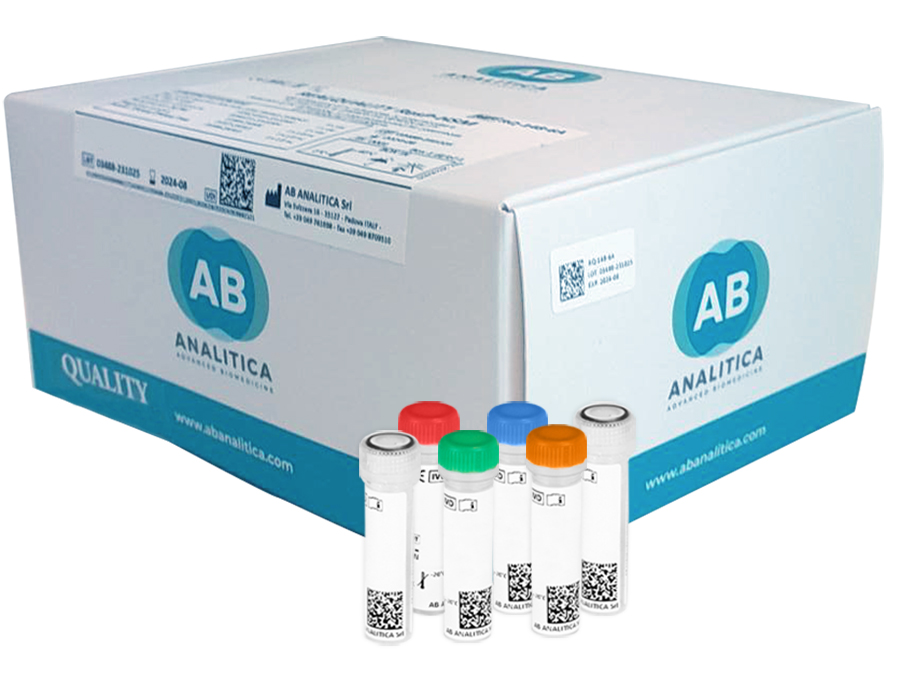Description
The REALQUALITY InFlu-Typing is an IVD for the identification of (H1N1) pdm09, H3N2, H5N1 and H7N9 subtypes of Influenza A in respiratory samples from patients with signs and symptoms of respiratory infection by Real-Time PCR.
Product Characteristics
- The device is validated on RNA extracted from various samples types
- The assay requires only 5 µL of RNA extracted
- Validated on main Real-Time PCR instruments
- The automatic format of the assay can be used used on GENEQUALITY® automatic platforms
- Easy interpretation of results with AB Genius Report software
Kit content
Kit content:
- Freeze-dried reagents for real time PCR amplification
- Extraction control (freeze-dried)
- Positive control (freeze-dried)
- Negative control
- Rehydration Buffer (solution to reconstitute the freeze-dried products)
- Water RNAse/DNAse free
Further Information
The influenza virus is a single-stranded RNA virus with negative polarity ((-) ssRNA). It is classified into four types: A, B, C and D based on their nucleoproteins and matrix proteins; types A and B are responsible for major human diseases, and influenza A is the only virus responsible for influenza pandemics due to the presence of two surface proteins called hemagglutinin (H) and neuraminidase (N).
Seasonal outbreaks are caused by both influenza A and B viruses; the two subtypes of influenza A virus, H1N1 and H3N2, are known to have caused many influenza pandemics.
Among the subtypes of this virus, (H1N1) pdm09 is particularly important as it caused a global pandemic in 2009, resulting in illnesses, hospitalizations and deaths: the virus has spread to over 70 countries and in all 50 states United. The virus was initially referred to as swine influenza virus, but it is a combination of swine, avian and human influenza viruses. Subsequently, the virus name was standardized to influenza A (H1N1) pdm09 to indicate the pandemic and to distinguish the virus from seasonal H1N1 strains and the 1918 pandemic H1N1 strain. Since 2009, Influenza A (H1N1) pdm09 has been circulating as seasonal influenza.
The subtype H3N2 (A(H3N2)) Influenza A viruses have been the dominant strain in some countries in the Western Pacific region since the 2009 influenza A(H1N1) pandemic.
The subtypes A(H5N1) and A(H7N9) of avian influenza virus appeared in China in 2003 and 2013, respectively. The influenza A(H5N1) virus spread from Asia to Europe and Africa and has taken root in the poultry populations of some countries.
Influenza is a viral respiratory infection that causes fever, coryza (cold), cough, headache and malaise but can lead to complications such as pneumonia, bloody sputum, wheezing and wheezing. Mortality is possible during seasonal outbreaks, particularly among high-risk patients: pregnant women, children aged 6 months to 5 years, elderly adults, and people with underlying medical conditions that make them vulnerable to serious complications of influenza during pandemics, even young and healthy patients can die. Influenza viruses can be spread by airborne droplets, person-to-person contact, or contact with contaminated objects. Airborne spread appears to be the most important mechanism.
Ordering Information
| Code | Product | PKG |
|---|---|---|
| RQ-141-6A | REALQUALITY InFlu-Typing - Manual and automatic format | 96 tests |









